Keyword: Harmful algal blooms (HABs)

Belfiore, A., R. P. Buley, E. G. Fernandez-Figueroa, M. Gladfelter, and A. E. Wilson. 2021. Zooplankton as an alternative method for controlling phytoplankton in catfish pond aquaculture. Aquaculture Reports 21:100897.
Abstract
In pond aquaculture, production of toxins and off-flavor compounds by cyanobacteria can negatively affect fish health and production. Studies have explored chemical or physical methods for controlling algal blooms in aquaculture ponds, which although effective, may be short-lived and can negatively impact non-target organisms, including aquaculture species. Food web manipulations have a long history in lake and fisheries management to improve water quality, but have been rarely considered in aquaculture. This study examined zooplankton and phytoplankton communities, cyanobacterial toxins, and nutrients in nine catfish aquaculture farm-ponds in west Alabama, USA. The goal of this project was to track phytoplankton and zooplankton abundances with respect to each other, with and without efforts to reduce zooplanktivorous fish in some of the ponds. During this project, farm managers reduced zooplanktivorous fish abundance in select ponds to create a large-scale field experiment that addressed the role of zooplankton control of phytoplankton in hypereutrophic catfish aquaculture ponds when zooplanktivorous fish were or were not excluded. There was a strong negative effect of zooplankton on phytoplankton, including cyanobacteria, despite high nutrient concentrations. Although high zooplankton ponds sustained elevated zooplankton biomass during much of this study, including when pond temperatures exceeded 30 °C, the effect of zooplankton on phytoplankton was most pronounced during the non-growing season (November–April). In addition, total ammonia nitrogen was significantly higher in high zooplankton ponds, which could lead to ammonia toxicity in fish at elevated temperature and pH. Our findings suggest that zooplankton biomanipulation may be an efficient method to control algal blooms in farm-pond catfish aquaculture.
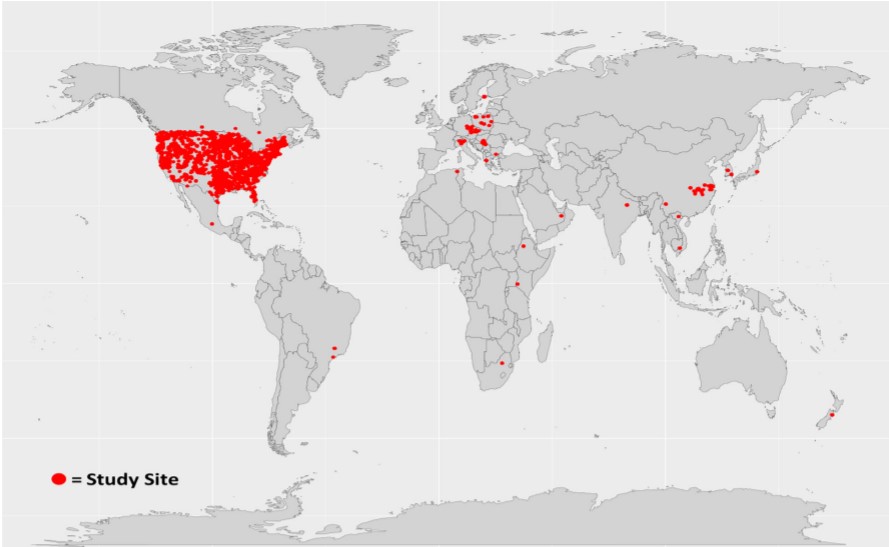
Buley, R. P., H. E. Correia, A. Abebe, T. B. Issa, and A. E. Wilson. 2021. Predicting microcystin occurrence in freshwater lakes and reservoirs: assessing environmental variables. Inland Waters 11(3):430-444.
Abstract
Determining the environmental conditions that influence the occurrence and concentration of the cyanobacterial toxin microcystin (MC) is a critical step for predicting cases in which the toxin will adversely affect drinking water sources, recreational waterbodies, and other freshwater ecosystems. Although widely studied, little consensus exists regarding the factors that influence MC on a global scale. The objective of this study was to identify the environmental variables most strongly associated with MC concentrations using observational data from lakes and reservoirs around the world while also addressing the substantial proportions of missing values that a large aggregated dataset often involves. A total of 124 studies containing data from an estimated 2040 lakes and reservoirs in 22 countries was used to construct a global dataset. Variables including <35% of non-missing observations were removed prior to analysis. Missing values for the remaining 12 predictors of MC were imputed using an iterative imputation algorithm based on a random forest approach. Variable selection was performed with generalized additive modeling on the complete case and imputed datasets. Models applied to the imputed data produced lower prediction errors than those fit to the complete dataset. Variables of greatest significance to MC concentration included location (longitude–latitude pairs), total nitrogen, turbidity, and pH. Total phosphorus was not found to be a strong predictor of MC. In addition to assisting water resource managers in protecting their waterbodies against MC, the presented methodologies may provide a useful framework for future water quality modeling while accounting for varying proportions of missing data.
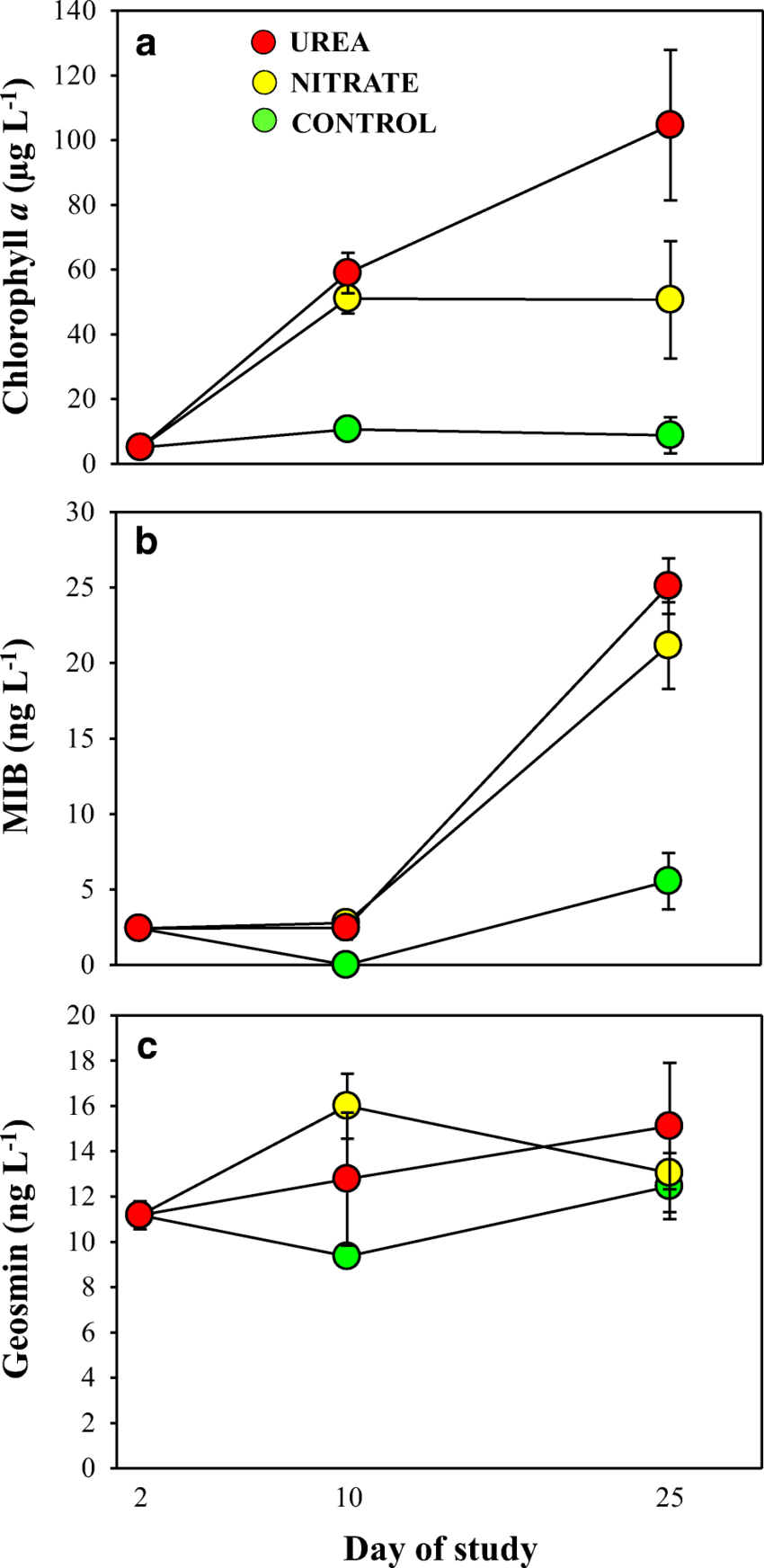
Chislock, M. F., B. K. Olsen, J.J. Choi, A. Abebe, T. L. Bleier, and A. E. Wilson. 2021. Contrasting patterns of 2-methylisoborneol (MIB) vs. geosmin across depth in a drinking water reservoir are mediated by cyanobacteria and actinobacteria. Environmental Science and Pollution Research 28:32005-32014.
Abstract
Taste and odor episodes caused by off-flavor secondary metabolites, such as 2-methylisoborneol (MIB) and geosmin, pose one of the greatest challenges for drinking water utilities around the world. The prevalence of these compounds is predicted to increase in the future as a function of nutrient enrichment and elevated temperatures of surface drinking water sources. We conducted a manipulative field experiment in a drinking water reservoir to elucidate patterns for two taste and odor compounds, MIB and geosmin, as well as two taxa known to produce these compounds, phytoplankton (more specifically, cyanobacteria) and actinobacteria, across different depths in response to nutrient enrichment with two common dissolved nitrogen forms, organic urea or inorganic nitrate. In general, we found that MIB levels increased by greater than 250% with nutrient enrichment mediated by increased phytoplankton biomass. However, the effect of the fertilization treatments on MIB decreased with depth with a 35% reduction at 7 m versus 1.5 m. In contrast, geosmin levels reached a maximum at the lowest measured depth (7 m), were unaffected by the fertilization treatments, and followed a similar pattern to the abundance of actinobacteria. Thus, our data suggest that the positive response of phytoplankton (e.g., cyanobacteria, such as Oscillatoria species) to the fertilization treatments is likely responsible for increased MIB, while geosmin concentrations may be a function of actinobacteria-mediated decomposition in the hypolimnion in our study system.
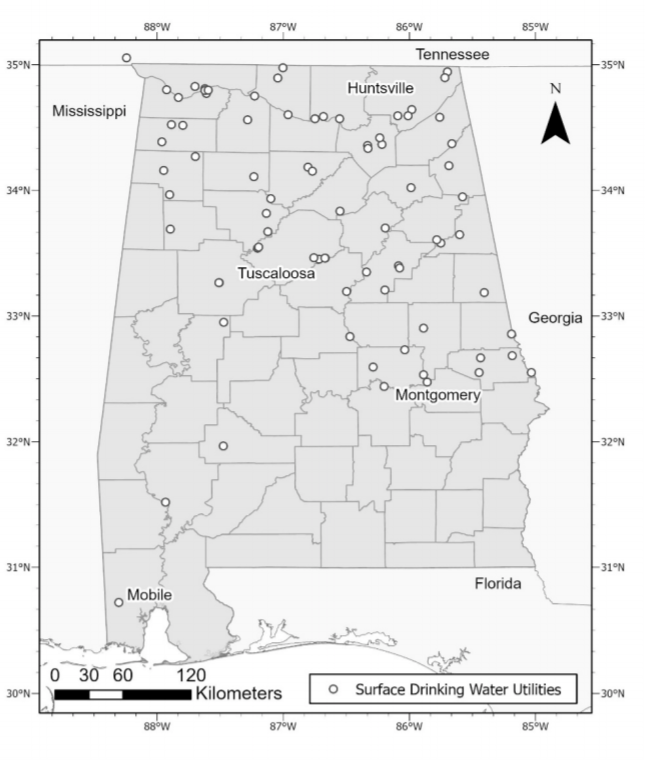
Fernandez-Figueroa, E. G., R. P. Buley, M. U.G. Barros, M. F. Gladfelter, W. D. McClimans, and A. E. Wilson. 2021. Carlson’s trophic state index is a poor predictor of cyanobacterial dominance in drinking water reservoirs. AWWA Water Science 3(2):e1219.
Abstract
A 20-month survey of 71 surface drinking water utilities across 44 waterbodies was conducted to determine whether the commonly used Trophic State Index (TSI) is a reliable indicator of eutrophication in drinking water sources. Raw water quality results showed that cyanobacteria, cyanotoxins (i.e., microcystin), and taste and odor (T&O) compounds (i.e., 2-methylisoborneol and geosmin) were generally low in the utilities sampled. TSI values based on chlorophyll concentrations (TSI Chl-a) were closely related to phytoplankton, cyanotoxin, and T&O concentrations and indicated that most drinking water sources were mesotrophic or eutrophic. However, TSI values based on total phosphorus (TSI TP) indicated that the drinking water sources were eutrophic or hypereutrophic. These results suggest that TSI Chl-a is a better predictor of cyanobacteria and their compounds than TSI TP. Phytoplankton abundance decreased with depth; therefore, managers should consider switching to deeper intakes when TSI Chl-a values increase to reduce removal costs.
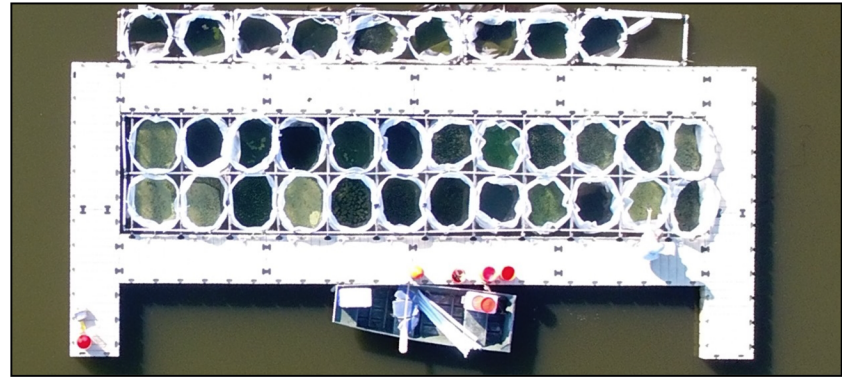
Buley, R. P., C. Adams, A. P. Belfiore, E. G. Fernandez-Figueroa, M. F. Gladfelter, B. Garner, D. L. Straus, and A. E. Wilson. 2021. Field evaluation of seven products to control cyanobacterial blooms in aquaculture. Environmental Science and Pollution Research 28:29971-29983.
Abstract
Harmful algal blooms negatively impact water quality in hypereutrophic systems that are common in aquaculture. However, few algaecides are approved for use in food-fish aquaculture. This study assessed the effectiveness of seven products, including hydrogen peroxide (as a concentrated liquid or in granular form (PAK-27)), peracetic acid (as VigorOx SP-15 and Peraclean), copper (as copper sulfate in unchelated (powder) or chelated (Captain) forms), and a clay-based product (as Phoslock) on phytoplankton (including cyanobacteria) and zooplankton biomass. Each product was tested in a 14-day laboratory and 35- day field experiment to assess their short- and long-term performance. Although some products (i.e., copper-based and liquid hydrogen peroxide) quickly reduced phytoplankton, effects were short-lived given that chlorophyll concentrations returned to starting concentrations within 21 days. In contrast, all but one product (i.e., concentrated liquid hydrogen peroxide) maintained low phycocyanin concentrations for 35 days. Zooplankton biomass trends showed large, negative effects for most algaecides; however, zooplankton rebounded for most treatments except for copper-based products. In general, copper-based products remain the most efficient and cheapest choice to reduce total phytoplankton biomass in aquaculture systems. However, peracetic acid-based products effectively and quickly reduced cyanobacteria while having marginal effects on beneficial algae and zooplankton. Such algaecides could be effective alternatives to copper-based products for aquaculture farmers. Hydrogen peroxide . Peracetic acid . Copper . Clay . Harmful algal blooms . Chemical control
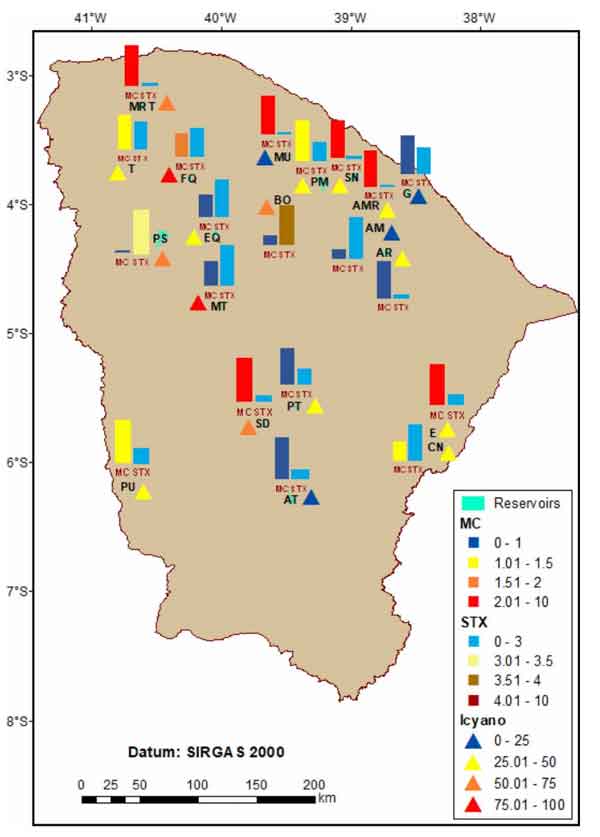
Barros, M. U.G., J. I.R. Leitão, T. R.B.T. Aranha, S. Simsek, R. P. Buley, E. G. Fernandez-Figueroa, M. F. Gladfelter, A. E. Wilson, and J. Capelo-Neto. 2020. Icyano: A cyanobacterial bloom vulnerability index for drinking water treatment plants. Water Supply 20(8):3517-3530.
Abstract
Managing freshwater systems has become a challenge for global water utilities given that cyanobacterial blooms have been increasing in frequency and intensity. Consequently, a water quality index that uses conventional measurements to assess toxic cyanobacterial hazards and guide the selection of proper treatment technologies could benefit water resource managers about water quality parameters routinely analyzed in line with environmental changes. An index model, called Icyano, showed that chlorophyll-a, cyanobacterial concentration, and total nitrogen were most important for the index. All reservoirs classified as good by Icyano used direct filtration water treatment technology. Many of the medium Icyano-classified reservoirs used a pre-treatment unit followed by a direct filtration unit. Two reservoirs that were classified as bad or very bad have been utilizing pre-treatment þ direct filtration or a complete cycle technology, respectively. As the Icyano index increases, water treatment plants should switch from direct filtration to using a pre-treatment to improve finished water quality. Findings from this project suggest that the direct filtration technology initially used in water treatment plants is not capable of meeting the current water quality guidelines in reservoirs that contain adverse water quality conditions, mostly related to an increase in toxic cyanobacterial blooms. As such, based on our findings, we recommend prioritizing financial resources towards pre-treatment technology or changes to more advanced technologies when Icyano index values increase.

Powers, M. J., A. E. Wilson, K. B. Heine, and G. E. Hill. 2020. The relative importance of various mating criteria in copepods. Journal of Plankton Research 42(1):19-30.
Abstract
To produce viable offspring, organisms may assess mates via criteria that include traits, such as sex, species, age, reproductive status, population identity and individual quality. Copepods are small, ubiquitous crustaceans that live in freshwater and marine systems around the world whose patterns of mate choice have been long studied in numerous species. Herein, we synthesized decades of experiments describing sexual selection in copepods to assess the importance of mating criteria. We used formal, meta-analytical techniques and mixed modeling to quantify the likelihood of non-random mating associated with mating criteria. In our synthesis of the scientific literature, we found that copepods use several criteria when assessing mates and that these criteria are associated with different likelihood estimates. We report the strongest likelihood of non-random mating when copepods assess the reproductive status of females or when copepods select between conspecific vs. heterospecific mates. We found weak likelihood of non-random mating in studies that provide mates from different populations or that manipulate operational sex ratio. Studies that directly test assessment of individual quality are sparse in copepods when compared to equivalent studies in vertebrates, and we encourage future researchers to explore whether copepods use individual characteristics as key mating criteria.
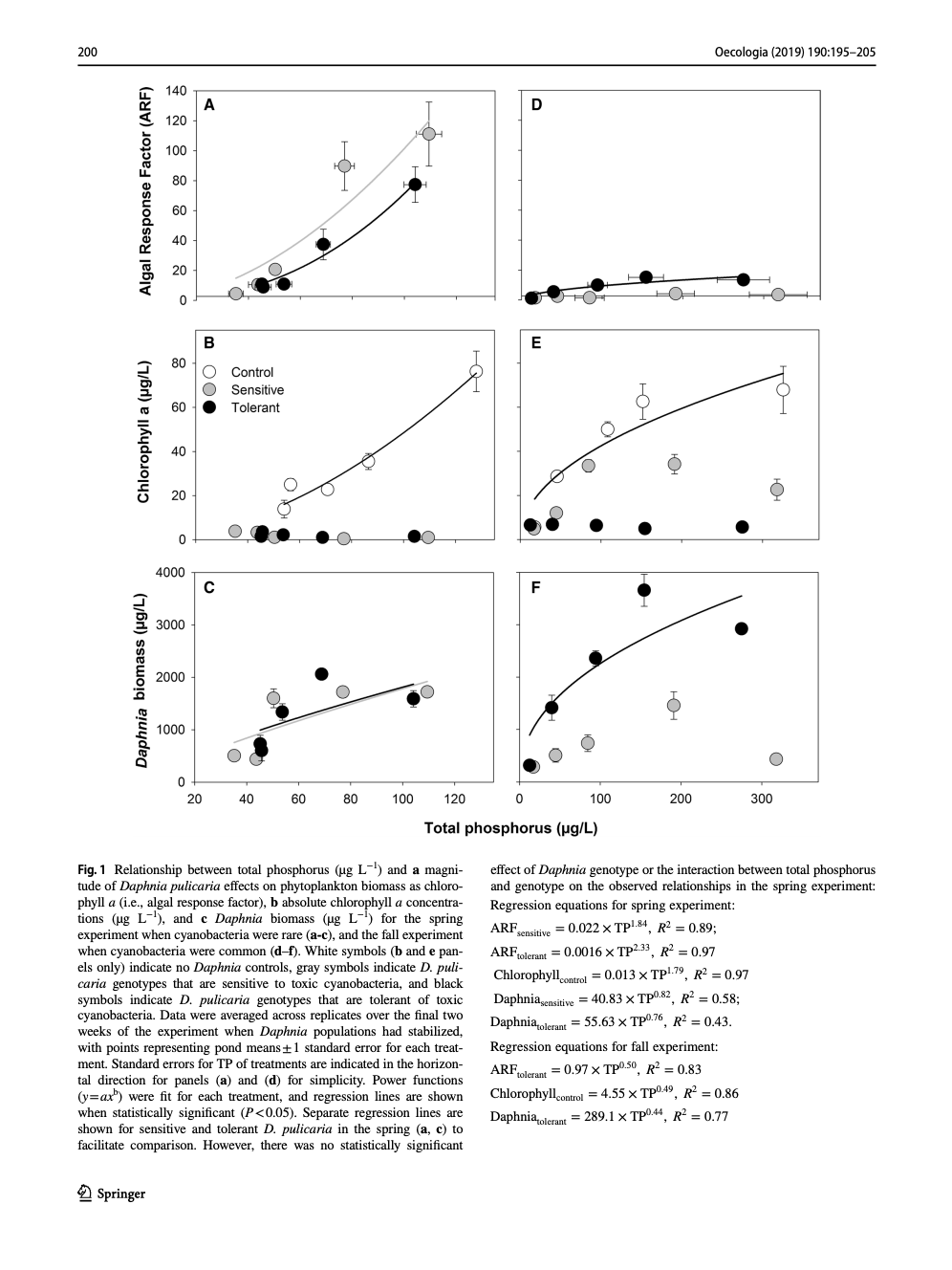
Chislock, M. F., O. Sarnelle, L. M. Jernigan, V. R. Anderson, A. Abebe, and A. E. Wilson. 2019. Consumer adaptation mediates top-down regulation across a productivity gradient. Oecologia 190:195-205.
Abstract
Humans have artificially enhanced the productivity of terrestrial and aquatic ecosystems on a global scale by increasing nutrient loading. While the consequences of eutrophication are well known (e.g., harmful algal blooms and toxic cyanobacteria), most studies tend to examine short-term responses relative to the time scales of heritable adaptive change. Thus, the potential role of adaptation by organisms in stabilizing the response of ecological systems to such perturbations is largely unknown. We tested the hypothesis that adaptation by a generalist consumer (Daphnia pulicaria) to toxic prey (cyanobacteria) mediates the response of plankton communities to nutrient enrichment. Overall, the strength of Daphnia’s top–down effect on primary producer biomass increased with productivity. However, these effects were contingent on prey traits (e.g., rare vs. common toxic cyanobacteria) and consumer genotype (i.e., tolerant vs sensitive to toxic cyanobacteria). Tolerant Daphnia strongly suppressed toxic cyanobacteria in nutrient-rich ponds, but sensitive Daphnia did not. In contrast, both tolerant and sensitive Daphnia genotypes had comparable effects on producer biomass when toxic cyanobacteria were absent. Our results demonstrate that organismal adaptation is critical for understanding and predicting ecosystem-level consequences of anthropogenic environmental perturbations.
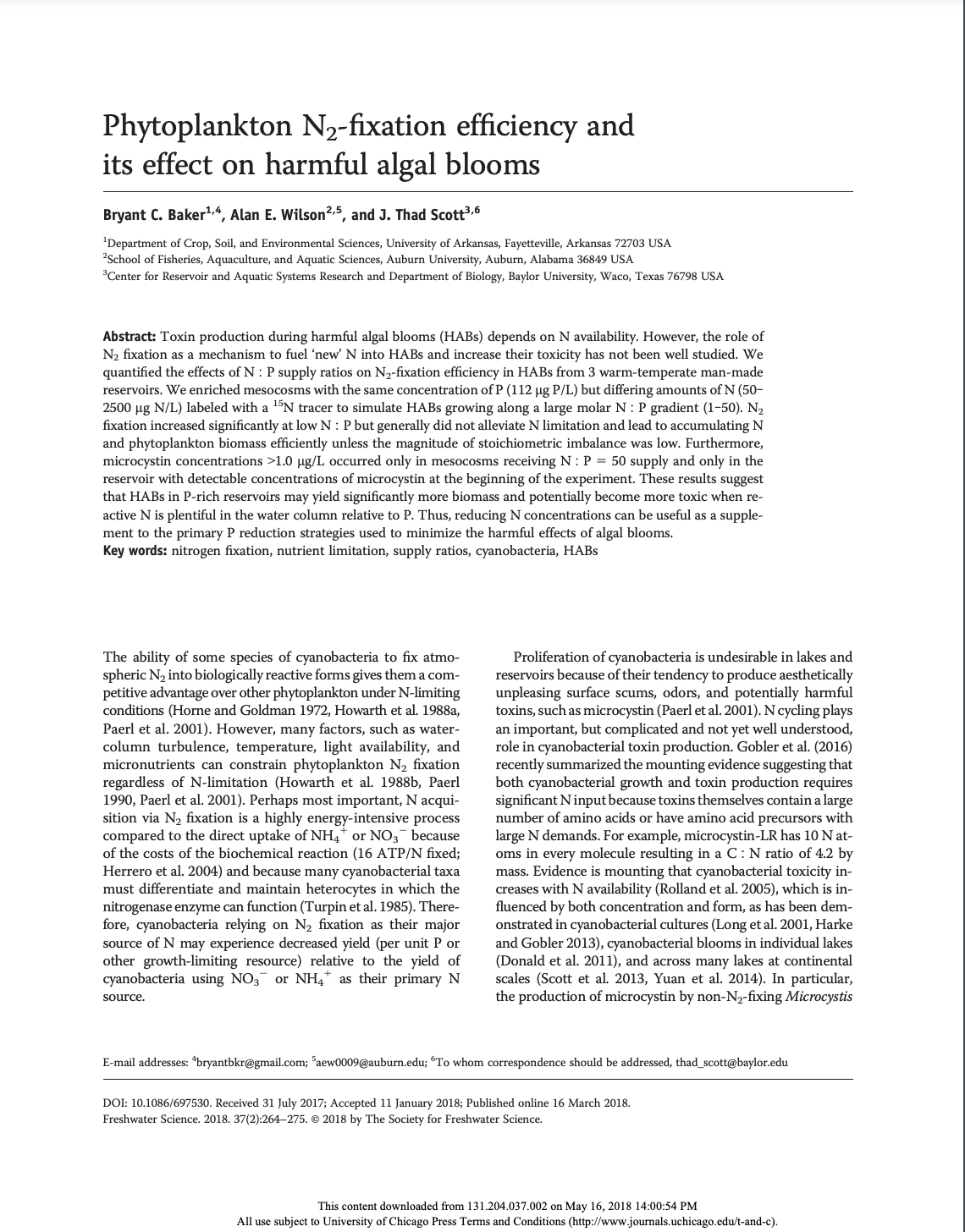
Baker, B. C., A. E. Wilson, and J. T. Scott. 2018. Phytoplankton N2 fixation efficiency and its effect on harmful algal blooms. Freshwater Science 37(2):264-275.
Abstract
Toxin production during harmful algal blooms (HABs) depends on N availability. However, the role of N2 fixation as a mechanism to fuel ‘new’ N into HABs and increase their toxicity has not been well studied. We quantified the effects of N∶P supply ratios on N2-fixation efficiency in HABs from 3 warm-temperate man-made reservoirs. We enriched mesocosms with the same concentration of P (112 µg P/L) but differing amounts of N (50‒2500 µg N/L) labeled with a 15N tracer to simulate HABs growing along a large molar N∶P gradient (1‒50). N2 fixation increased significantly at low N∶P but generally did not alleviate N limitation and lead to accumulating N and phytoplankton biomass efficiently unless the magnitude of stoichiometric imbalance was low. Furthermore, microcystin concentrations >1.0 µg/L occurred only in mesocosms receiving N∶P = 50 supply and only in the reservoir with detectable concentrations of microcystin at the beginning of the experiment. These results suggest that HABs in P-rich reservoirs may yield significantly more biomass and potentially become more toxic when reactive N is plentiful in the water column relative to P. Thus, reducing N concentrations can be useful as a supplement to the primary P reduction strategies used to minimize the harmful effects of algal blooms.
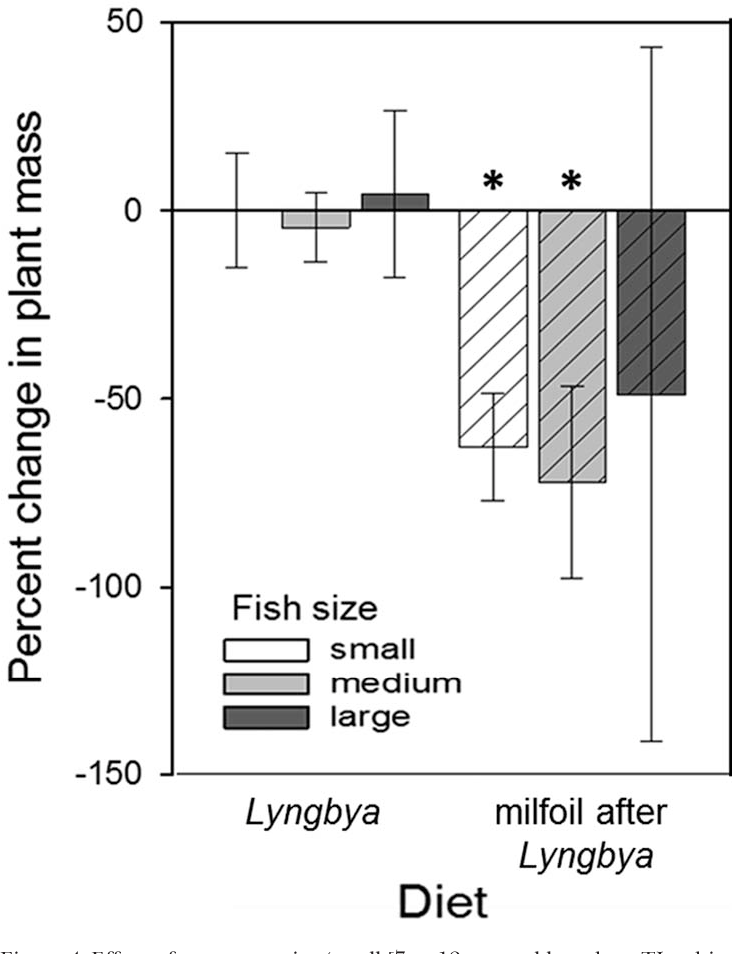
Kasinak, J.-M. E., C. J. Bishop, R. A. Wright, and A. E. Wilson. 2015. Grass carp do not consume the nuisance benthic cyanobacterium, Lyngbya wollei. Journal of Aquatic Plant Management 53:74-80.
Abstract
Grass carp, Ctenopharyngodon idella, (Cuvier and Valenciennes, 1844) are an effective biological control for many aquatic plants, especially submersed macrophytes and macrophytic algae. Despite limited data, grass carp are sometimes promoted as a tool for controlling filamentous algae, including some cyanobacteria, in small impoundments. One important cyanobacterium, Lyngbya wollei (Farlow ex Gomont) comb, nov., is a nuisance species in North America that forms benthic mats and surface scums and can produce multiple intracellular toxins and off-flavor compounds. Current management of Lyngbya calls for approaches similar to those for other nuisance algae, including chemical control using herbicides and biological control using grass carp when herbicides are not practical. Although agency biologists and private consultants recommend stocking grass carp to control filamentous algae, no conclusive empirical data show that grass carp consume Lyngbya. We conducted mesocosm experiments where different densities of grass carp of varying sizes were fed diets either containing a macrophyte, variable watermilfoil (Myriophyllum heterophyllum Michx.) and/or Lyngbya. In general, grass carp did not consume Lyngbya when offered by itself pr with milfoil, regardless of carp density or size. To test one mechanism mediating the lack of Lyngbya consumption by grass carp (i.e., chemical ecology), a feeding experiment where ground Lyngbya was fed to grass carp in agar pellets suggests that the secondary chemistry of Lyngbya prevents grass carp consumption. Although anecdotal observation suggests that high rates of grass carp stocking appear to Control Lyngbya, the results of this study suggest that the mechanism of control is not direct consumption (e.g., physical disruption of the benthic mats).